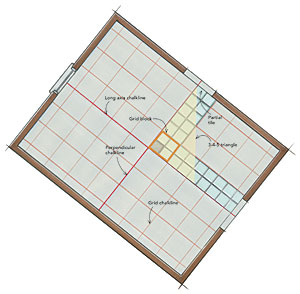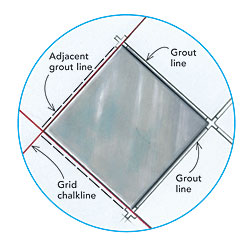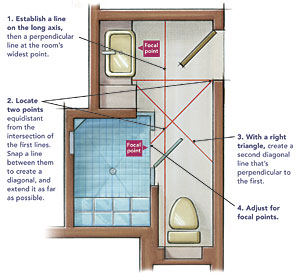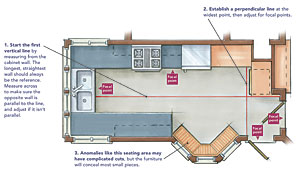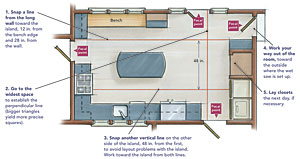For Great Tile Floors, Layout Is Everything
Take time to snap a few chalklines and find where the cuts are, and tiling becomes an easier task with better results.

Have you ever noticed the hallmarks of a bad tile layout? Slivers of tile at doorways or a line of tile that’s not parallel to a long wall? I certainly have. A great tile installation doesn’t start with the mortar, the wet saw, or even the grout. It starts with a proper layout. Not only will a well-planned tile floor or wall look better, but it also can save money by reducing waste.
I spend up to a day laying out a tile job before I do anything else. Essentially, I create a grid on the floor that tells me where the tiles will land. By determining a layout and shifting it as necessary, I can reduce cutting and eliminate the most difficult cuts, such as those around vents, outlets, and plumbing fixtures. Of course, I’ll still have to cut around those obstacles, but with careful planning, I can make sure they don’t fall inside a single tile, which can take far longer than making a couple of straight or U-shaped cuts in adjoining tiles. The whole idea is to streamline the process for the installer, which almost always yields a better tile job.
Establish a reference
To create a layout grid, you need to know the size of the tiles. This determines the size of the grid squares. From there, you can establish horizontal and vertical reference lines, and superimpose the grid on the floor.
I start by laying a few tiles side by side along a straightedge, each separated by the width of the grout joint that I plan to use, and then measuring the length of the group plus a line of grout on one outside edge. I’m aiming for a unit of measure that’s between 24 in. and 36 in., a distance I can comfortably reach on a typical floor installation.
Once I determine the unit measurement, I snap a reference chalkline parallel to the longest straight wall in the room. That reference line can be any distance from any wall, including a centerline between two main walls, or the reference line can be the cumulative measurement of tiles and grout joints from a single wall.
Next, I measure from that line to various stops, such as walls, entryways, and cabinet bases, to determine the cuts I’ll have. I always plan for at least half a tile at the most obvious places—doorways and long, visible walls, for example. In some cases, it’s impossible to have large pieces everywhere, so I place narrow pieces in closets, under cabinet toe kicks, or behind toilets.
If my first reference line doesn’t give me a layout that works, I erase the line with a damp sponge, adjust the location, and snap a new one. Then I snap lines at the unit-measure increments parallel to my reference line. It’s critical to make sure the measurements are precise; a 1⁄4-in. or even 1⁄8-in. error can throw off the entire layout.
Transfer the grid to the floor
Before I snap final lines, I review where the cuts will fall and then determine the best starting point. I choose an arbitrary point on my primary reference line and then measure in unit-measure increments to determine the locations of the cut tiles so that the largest pieces are in the most visible areas.
Once I determine my reference point on the vertical lines, I make a right triangle using the simple 3-4-5 rule governing right triangles. I use the longest combination of numbers, which will give me a longer perpendicular line. This serves as my primary horizontal line. I then snap lines at unit-measure increments, creating a grid of equal blocks on the entire floor. With that grid, I can start anywhere on the floor, as long as I remember that the tiles in each square must be started in the same corner. That allows me to fill in places that I might not be able to reach if I work in a continuous path—inside small closets, under appliances, and in tight corners.
A GRID REVEALS THE LAYOUT BEFORE INSTALLATION
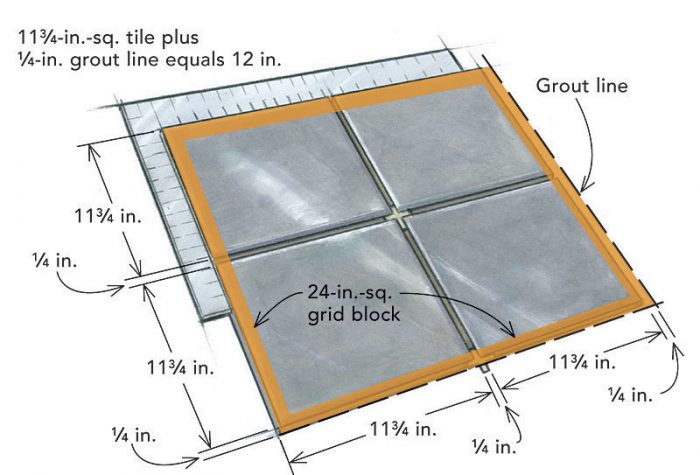
Find the unit of measure first Arrange several tiles into a square block that will form the basis of the grid. The ideal block dimensions range from 24 in. to 32 in. sq. Include space for grout lines on two adjoining sides of each tile in the measurement. In this example, four tiles create a 24-in.-sq. block.
Create reference lines on the floor Once the block size is known, measure and snap a chalkline along the axis of the room’s length. Ideally, the line should be parallel to both walls. Next, pick the widest area of the room and, using a Pythagorean principle (that of the 3-4-5 triangle), establish a perpendicular line to the first. The larger the triangle, the more accurate the perpendicular line.
Check the measurements and adjust Using the block as a unit of measurement, check the distances from the reference lines to the focal points. The ideal is to end with a half tile or more. Adjust the line (and grid layout) if the partial tile is less than half. When the layout is adjusted, snap a grid of chalklines that define each block or a multiple of blocks.
Orient tiles from the same point When tiles are installed within the grid, they all must be aligned to the same corner of each square. For instance, if the top and left sides are placed directly on the chalkline, space for a grout line will be included in the measurement at the bottom and right of the tile so that they integrate with the adjacent tile block. This way, installers can start in different parts of a room, and when they meet, their work will match.
Diagonal grids start the same
Floors installed on a diagonal take a little more time to lay out, but the steps are basically the same. To start, I mark a centerline down the longest portion of the room and then snap a perpendicular line. Next, I measure an equal distance down one side of the horizontal line from the centerpoint and one side of the vertical line, and snap a chalkline through those marks. That gives me a diagonal reference line to determine cuts throughout the room. After I snap a series of lines, I can then go back and put down more lines to create a grid, following the same steps I use for tiles laid parallel to the room. Determining cuts on a diagonal can be much more time-consuming, and I often spend far more time working on the initial layout.
DIAGONAL LAYOUT IN A SMALL BATH
In this example, 6-in.-sq. tiles are to be installed in a diagonal 18-in. grid. The focal points are at the sink and shower door. Smaller cut pieces of tile can be hidden behind the toilet.
A SIMPLE GALLEY KITCHEN
In this example, 12-in. tiles in a 24-in. grid are laid over a long narrow plan. The focal points are at the sink, the cabinet kick spaces, and the doorways. The potential complicating factor here is the hexagonal eating nook.
A LARGER KITCHEN WITH OBSTRUCTIONS
In kitchens, independent structures like islands can cause problems. Again, 12-in. tiles are used to form a 24-sq.-in. grid. The focal points are determined by sightlines from entrances and at the doorways themselves.
A word about choosing tile
Many people say larger tiles make a smaller room look larger. I don’t buy that theory, but then again, I’m just a tile installer. To me, a room doesn’t look larger or smaller based on the size of the tile. I’m not a big fan of diagonal installations, either. The lines just get too overwhelming. Maybe that’s just me, because plenty of people like a diagonal layout. The fact is, tile size, patterns, and layout are really a matter of personal taste. When dealing with a client, I do a dry run and lay a bunch of tiles on the floor both ways (straight and diagonal), then let the client decide between them.
My personal preference is for larger tiles. I think they look better, especially in larger rooms, but I’ve also done some installations with 18-in. by 18-in. tiles in smaller bathrooms and kitchens that looked great. Smaller tiles in big rooms, however, just look too busy; there are too many grout lines. Ultimately, what’s really important is for the floor to look as though it has been there forever.
David Hart is a tile contractor in Rice, Va. Drawings by Bob La Pointe. Photo: Sandor Nagyszalanczy.
From Fine Homebuilding #214

